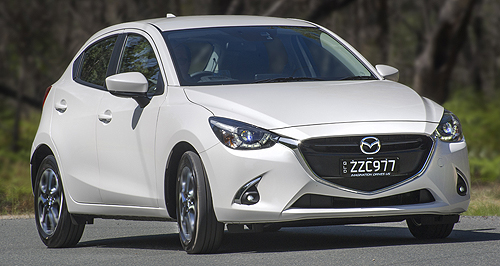News - MazdaMazda right to resist downsizing: HiroseDown down: Mazda has resisted the trend of downsized engines that other car-makers have followed. Ignoring small-capacity trend vindicated in real-world economy figures, says Mazda11 Sep 2017 By BYRON MATHIOUDAKIS in FRANKFURT THE head of Mazda’s powertrain development says the company’s decision to not follow the lead of other car-makers in downsizing its turbo-petrol engines when it began working on the SkyActiv engines in 2008 was the right move. Mazda Motor Corporation managing executive officer in charge of powertrain and vehicle development and product planning, Ichiro Hirose, said this was the correct path, with rival manufacturers recently increasing the size of their engines to achieve better real-world fuel-consumption tests, while Mazda has not needed to with its SkyActiv-G (petrol) and SkyActiv-D (diesel) powertrains. This includes Volkswagen with the latest Golf’s new European-market 1.5-litre unit, up from the old 1.4. “Of course I am aware in the market that OEMs (Original Equipment Manufacturers) are tending towards downsizing, and in terms of that they have been looking at three cylinders with (as little as) 1.0-litre engines – that is true,” he told GoAuto through an interpreter at Mazda’s 2017 Global Tech Forum in Frankfurt. “But if you look at what the trend is now, especially in Europe, because we had NEDC (New European Driving Cycle) before and we’ve changed to WLTC (Worldwide harmonized Light vehicles Test Procedure), manufacturers who were downsizing previously are now upsizing their engines to get better real-world fuel economy.” Mr Hirose said that as a result, it is not yet necessary for Mazda to develop an engine below the existing 1.3-litre petrol and 1.5-litre diesel units, especially as the new supercharged compression ignition technology (dubbed SkyActiv-X) that can bring upwards of 30 per cent consumption and emissions cuts is adaptable to any size and configuration of SkyActiv-era engine. “If the question was regarding downsizing in that sense then no, we won’t be looking at that sort of avenue because that is not going to give the real efficiencies that customers need,” he explained. “Now if we talk pure technological point of view of decreasing displacements, we have based this (SkyActiv-X) engine development on single-cylinder development, and because of this we’ve been able to get the optimal displacement. “So we’ve combined these four cylinders on the engine with the optimal displacement that we think will be apt. But we can also decrease that to three cylinders and increase displacement as required (as future needs evolve).” Ultimately this also means that a sub-Mazda2, ‘Mazda1’ micro car to compete with the Kia Picanto or Volkswagen Up is probably not in the pipeline for launch any time soon, as the current Mazda2 from the class above will eventually evolve with the SkyActiv-X tech option to render such a move superfluous. “We are a small company and do not have the resources to do so,” said one Mazda source. As a further disincentive to do so Suzuki already provides most Japanese OEMs with the sub-660cc Kei-cars that dominate that country’s market, including the Alto-based Carol in Mazda’s case.  Read more10th of September 2017  Mazda ‘SkyActiv-X’ to run alongside current enginesNew blown compression-ignition engines to sell alongside current powertrains: Mazda8th of September 2017  Mazda backs future of diesel engineHi-tech SkyActiv-X oil-burner up next as Mazda keeps faith in diesel engines7th of September 2017  Mazda’s SkyActiv II platform evolves original’s basicsMost Mazda SkyActiv II parts are new but some carry over to save time, money |
Click to shareMazda articlesResearch Mazda Motor industry news |
















Facebook Twitter Instagram